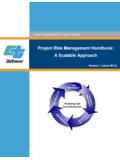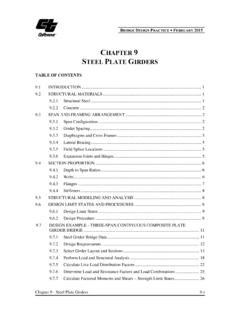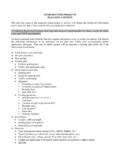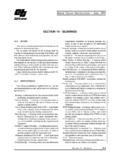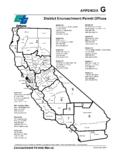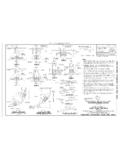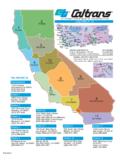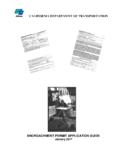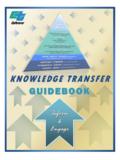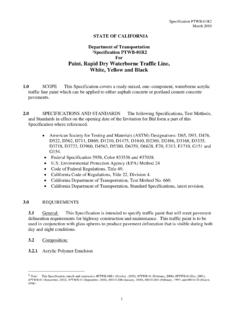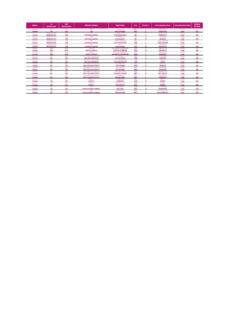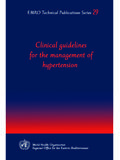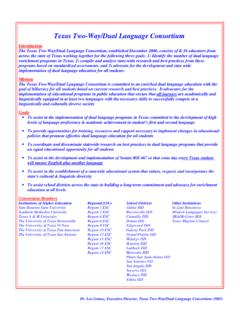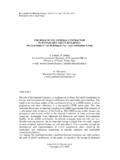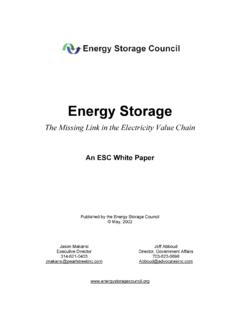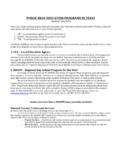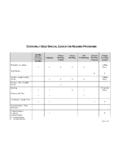Transcription of SECTION 9 - PRESTRESSED CONCRETE - Caltrans
1 BRIDGE DESIGN SPECIFICATIONS APRIL 2000 SECTION 9 - PRESTRESSED CONCRETE Part A General Requirements and Materials APPLICATION General The specifications of this SECTION are intended for design of PRESTRESSED CONCRETE bridge members. Mem bers designed as reinforced CONCRETE , except for a per centage of tensile steel stressed to improve service behav ior, shall conform to the applicable specifications of SECTION 8. Exceptionally long span or unusual structures require detailed consideration of effects which under this SECTION may have been assigned arbitrary values.
2 Notations As = area of non- PRESTRESSED tension reinforcement (Articles and ) A's = area of compression reinforcement (Article ) A*s = area of prestressing steel (Article ) Asf = steel area required to develop the compressive strength of the overhanging portions of the flange (Article ) Asr = steel area required to develop the compressive strength of the web of a flanged SECTION (Articles ) Av = area of web reinforcement (Article ) b = width of flange of flanged member or width of rectangular member bv = width of cross SECTION at the contact surface being investigated for horizontal shear (Article ) b' = width of a web of a flanged member CRc = loss of prestress due to creep of CONCRETE (Article ) CRs = loss of prestress due to relaxation of prestressing steel (Article ) D = nominal diameter of prestressing steel (Articles and )
3 + d = distance from extreme compressive fiber to cen troid of the prestressing force, or to centroid of negative moment reinforcing for precast girder bridges made continuous dt = distance from the extreme compressive fiber to the centroid of the non- PRESTRESSED tension rein forcement (Articles and ) ES = loss of prestress due to elastic shortening (Article ) e = base of Naperian logarithms (Article ) fcds = average CONCRETE compressive stress at the of the prestressing steel under full dead load (Article ) fcir = average CONCRETE stress at the of the prestress ing steel at time of release (Article ) f'c = compressive strength of CONCRETE at 28 days f'ci = compressive strength of CONCRETE at time of initial prestress (Article ) fct = average splitting tensile strength of lightweight aggregate CONCRETE , psi fd = stress due to unfactored dead load, at extreme fiber of SECTION where tensile stress is caused by externally applied loads (Article ) fpc = compressive stress in CONCRETE (after allowance for all prestress losses)
4 At centroid of cross SECTION resisting externally applied loads or at junction of web and flange when the centroid lies within the flange (In a composite member, fpc is resultant compressive stress at centroid of composite sec tion, or at junction of web and flange when the centroid lies within the flange, due to both pre stress and moments resisted by precast member acting alone.) (Article ) fpe = compressive stress in CONCRETE due to effective prestress forces only (after allowance for all pre stress losses) at extreme fiber of SECTION where tensile stress is caused by externally applied loads (Article ) SECTION 9 PRESTRESSED CONCRETE 9-1 BRIDGE DESIGN SPECIFICATIONS APRIL 2000 fps = guaranteed ultimate tensile strength of the pre stressing steel, A*sf's fr = the modulus of rupture of CONCRETE , as defined in Article (Article ) fs = total prestress loss, excluding friction (Article )
5 Fse = effective steel prestress after losses f*su = average stress in prestressing steel at ultimate load f's = ultimate stress of prestressing steel (Articles and ) fsy = yield stress of non- PRESTRESSED conventional rein forcement in tension (Article and ) f'y = yield stress of non- PRESTRESSED conventional rein forcement in compression (Article ) f*y = yield stress of prestressing steel (Article ) = f's for low-relaxation wire or strand = f's for stress-relieved wire or strand = f's for Type I (smooth) high-strength bar = f's for Type II (deformed) high-strength bar h = overall depth of member (Article ) I = moment of inertia about the centroid of the cross SECTION (Article ) K = friction wobble coefficient per foot of prestress ing steel (Article ) L = length of prestressing steel element from jack end to point x (Article ) Mcr = moment causing flexural cracking at SECTION due to externally applied loads (Article ) M*cr = cracking moment (Article ) Md/c = composite dead load moment at the SECTION (Com mentary to Article ) Md/nc= non-composite dead load moment at the SECTION (Article )
6 Mmax = maximum factored moment at SECTION due to externally applied loads (Article ) Mn = nominal moment strength of a SECTION Mu = factored moment at SECTION Mn (Articles and ) p = As/bdt, ratio of non- PRESTRESSED tension reinforce ment (Articles and ) p*= A*s/bd, ratio of prestressing steel (Articles and ) p' = A's/bd, ratio of compression reinforcement (Ar ticle ) Pu = factored tendon force Q = statical moment of cross-sectional area, above or below the level being investigated for shear, about the centroid (Article ) SH = loss of prestress due to CONCRETE shrinkage (Ar ticle ) s = longitudinal spacing of the web reinforcement (Article ) Sb = non-composite SECTION modulus for the extreme fiber of SECTION where the tensile stress is caused by externally applied loads (Article ) Sc = composite SECTION modulus for the extreme fiber of SECTION where the tensile stress is caused by externally applied loads (Article ) t = average thickness of the flange of a flanged mem ber (Articles and ) To = steel stress at jacking end (Article ) Tx = steel stress at any point x (Article )
7 V = permissible horizontal shear stress (Article ) Vc = nominal shear strength provided by CONCRETE (Ar ticle ) Vci = nominal shear strength provided by CONCRETE when diagonal cracking results from combined shear and moment (Article ) Vcw = nominal shear strength provided by CONCRETE when diagonal cracking results from excessive princi pal tensile stress in web (Article ) Vd = shear force at SECTION due to unfactored dead load (Article ) Vi = factored shear force at SECTION due to externally applied loads occurring simultaneously with Mmax (Article ) Vnh = nominal horizontal shear strength (Article ) Vp = vertical component of effective prestress force at SECTION (Article ) Vs = nominal shear strength provided by shear rein forcement (Article ) Vu = factored shear force at SECTION (Article ) Yt = distance from centroidal axis of gross SECTION , neglecting reinforcement, to extreme fiber in ten sion (Article ) = friction curvature coefficient (Article )
8 SECTION 9 PRESTRESSED CONCRETE 9-2 BRIDGE DESIGN SPECIFICATIONS APRIL 2000 = total angular change of prestressing steel profile in radians from jacking end to point x (Article ) = factor for CONCRETE strength, as defined in Article (Articles ) * = factor for type of prestressing steel (Article ) = for low-relaxation steel = for stress-relieved steel = for bars Definitions The following terms are defined for general use. Specialized definitions appear in individual articles. Anchorage device The hardware assembly used for transferring a post-tensioning force from the tendon wires, strands or bars to the CONCRETE .
9 Anchorage Seating Deformation of anchorage or seat ing of tendons in anchorage device when prestressing force is transferred from jack to anchorage device. Anchorage Spacing Center-to-center spacing of an 1chorage devices. Anchorage Zone The portion of the structure in which the concentrated prestressing force is transferred from the anchorage device into the CONCRETE (Local Zone), and then distributed more widely into the structure (General Zone) (Article ). Basic Anchorage Device Anchorage device meeting the restricted bearing stress and minimum plate stiffness requirements of Articles through ; no acceptance test is required for Basic Anchorage De vices.
10 Bonded Tendon Prestressing tendon that is bonded to CONCRETE either directly or through grouting. Coating Material used to protect prestressing ten dons against corrosion, to reduce friction between tendon and duct, or to debond prestressing tendons. Couplers (Couplings) Means by which prestressing force is transmitted from one partial-length prestressing tendon to another. Creep of CONCRETE Time-dependent deformation of CONCRETE under sustained load. Curvature Friction Friction resulting from bends or curves in the specified prestressing tendon profile. Debonding (blanketing) Wrapping, sheathing, or coating prestressing strand to prevent bond between strand and surroundi
